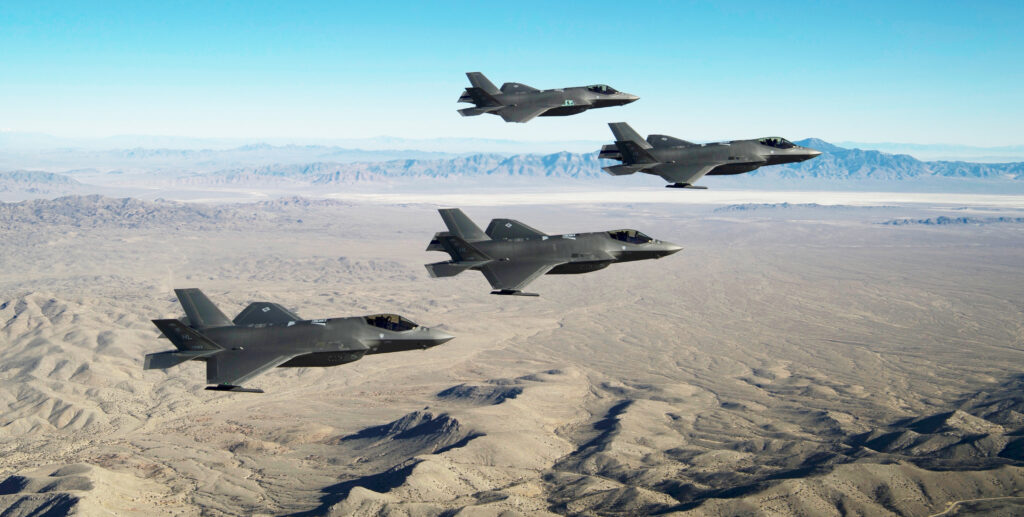
F-35As
WASHINGTON: The Air Force got authorization in the new NDAA for an extra $1 billion for 12 additional F-35As, but the new funds come with a raft of oversight measures and new reporting requirements.
A summary of the bill’s language put out by House Republicans states that the new planes are “to address an identified Air Force unfunded requirement and accelerate delivery of needed 5th generation capability and $440 million for the purchase of additional F-35s originally ordered by Turkey.”
Altogether, DoD asked for 78 F-35 Joint Strike Fighters in its budget request; the conference bill pumps that up to 90. The Senate version of the NDAA would have authorized 94; the Senate Appropriations Committee’s bill would have pumped the number to a whopping 96. The House NDAA bill authorized 90 — echoing House appropriators.
The NDAA agreement further provides “the necessary authority for buying F-35 long lead spare parts in bulk to help achieve better cost savings for the F-35 and authorizes buy-to-budget authority to capitalize on lower unit cost savings,” the summary states.
Congress also gave a thumbs up to 10 F-35Bs and 20 F-35Cs requested by the Navy and Marine Corps.
However, the lawmakers’ generosity comes with its own price tag. The bill requires a number of reports on the overarching F-35 program with an eye to increasing congressional oversight.
In particular, the DoD Comptroller must submit along with DoD’s fiscal 2021 budget request a report that provides:
- An assessment of “the progress of manufacturing processes improvement under the program;”
- A review of “the progress and results of the Block 4 Upgrade and Continuous Capability Development and Delivery Program and other follow-on modernization development and testing efforts.”
- An assessment of the DoD’s “schedule for delivering software upgrades in six month, scheduled increments.”
- A review of the “progress and results of any other significant hardware development and fielding efforts necessary for the F–35 Block 4 Upgrade and Continuous Capability Development and Delivery Program.”
In addition, Congress orders the Air Force and Navy Secretaries to jointly develop a joint service cost estimate for the life-cycle costs of the F–35 aircraft program and the Director of Cost Assessment and Program Evaluation to conduct another independent life-cycle cost estimate.
With an eye to the program’s long-standing troubles with readiness and sustainability, the NDAA conference report demands that DoD Acquisition czar Ellen Lord provide Congress with a sweeping study of “sustainment cost data related to the F–35 program, including a comparison in itemized forma of the cost of legacy aircraft and the cost of the F–35 program, based on a standardized set of criteria.” no later than 180 days after the bill is passed. This provision was included in the House Armed Services Committee version of the bill.
The study must include a cost-reduction plan for operation, maintenance and sustainability of the aircraft; a review of F-35 “reliability and maintainability metrics” to ensure that they are in line with operational requirements and determine whether improvements can be made; and a review of the ALIS logistics system.
With regard to other major Air Force programs, Congress fully authorizes the service’s $3 billion funding request for the B-21 Raider; and its $1 billion request for eight F-15EX aircraft to begin replacing aging F-15C/D Eagle aircraft with a proviso demanding a comprehensive report on the program; and $2.3 billion for 12 KC-46 Pegasus tankers.
Appropriators on both sides of Capitol Hill also fully funded the F-15EX request in their 2020 budget bills. The two sides are still locked in tough negotiations, especially over the Trump Administration’s request to shift operations and maintenance funding to the southern border wall.

F-15EX Boeing
As the Air Force begins gearing up to build the aircraft to succeed the F-35, the NDAA authorizes $955 million for the Air Force Next Generation Air Dominance (NGAD) Program, cutting the $1 billion request by $45 million — a far smaller cut than the House Armed Services Committee version of the NDAA that would have chopped the program in half.
But not everything went the Air Force’s way. The bill prevents the Air Force from spending any funds to retire the RC-135 reconnaissance aircraft until DoD Secretary Mark Esper “certifies to the congressional defense committees that equivalent RC-135 capacity and capability exists to meet combatant commander requirements for indications and warning, intelligence preparation of the operational environment, and direct support to kinetic and nonkinetic operations.”
Navy jet trainer fleet operations remain paused after engine mishap
One week after the incident, a Navy spokesperson says the service is continuing to assess the fleet’s ability to safely resume flight.


























